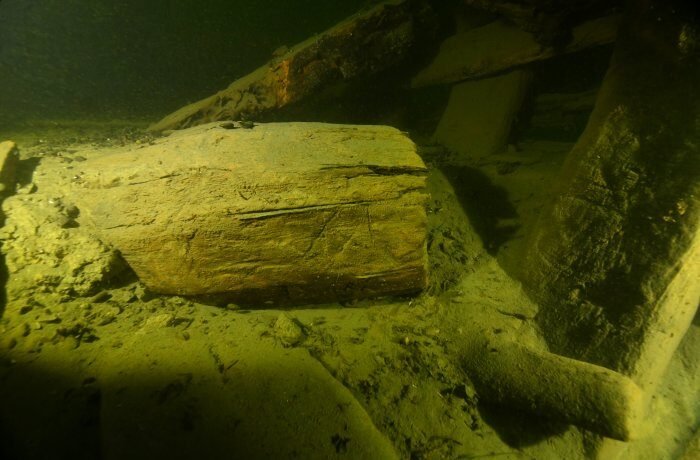Barrels With Unique Intact Cargo Found On The Osmundvraket (Osmond Wreck)

Ellen Lloyd – AncientPages.com – The Osmond wreck (Osmundvraket), a remarkable discovery from the 1550s, sheds light on the thriving iron trade during the reign of Gustav Vasa in Sweden.
In that era, a customs official in Stockholm inspected barrels filled with iron pieces, known as Osmond, destined for export. These barrels were loaded onto a ship, but its intended destination remains a mystery as the vessel never reached its final port and sank near Dalarö, southeast of Stockholm.
One of the barrels found on the Osmundsvraket. Credit: © Marco Ali, Vrak/SMTM
Osmond iron refers to a specific type of wrought iron produced through a particular process. This method is historically linked to the pioneering European production of cast iron in furnaces, such as the renowned Lapphyttan facility in Sweden. Notably, records of Osmonds can be traced back to some of the earliest English Customs accounts, with mentions dating as far back as 1325. This highlights the longstanding significance of this unique iron-making technique in the annals of metalworking history.
During this period, Stockholm was a hub for iron exports, with shipments frequently bound for cities like Gdansk, Lübeck, Copenhagen, the Netherlands, and England. While the exact destination of this particular vessel is unknown, it was likely en route to one of these prominent trade centers.
Written sources indicate that osmond iron was a significant export product from Sweden from the Middle Ages to the 17th century. Despite this, researchers have had limited knowledge about the precise nature of Osmond iron, its production process, and how it differed from other types of iron until recently.
3D model of Osmundsvraket. Credit: © Jim Hansson, Wreck/SMTM
The wreck, aptly named the Osmond wreck due to its unique cargo, remained undiscovered until 2017, over 460 years after its sinking. This remarkable find offers a fascinating glimpse into the maritime trade and export practices of 16th-century Sweden, providing valuable insights into the country’s economic and industrial history.
In an intriguing research endeavor, marine archaeologists from the Vrak – Museum of Wrecks have successfully salvaged barrels from a sunken ship in collaboration with the Iron Office. This remarkable undertaking was made possible through research grants provided by the Voice of the Ocean Foundation.
For a duration of two weeks, the marine archaeologists from the Vrak Museum have been diligently working on-site at the wreck location. During this period, they meticulously excavated the cargo and, with utmost precautions, managed to move one of the approximately 20 barrels found on board to a lifting device.
Fishing harbor (Fiskarhamnen) in Dalarö (Haninge municipality, Stockholm archipelago, Sweden). Credit: Markus Bernet – CC BY-SA 2.5
In the presence of a mass media gathering, the barrel containing osmotic iron was lifted out of the water for the first time in nearly 500 years. With its load visible, the partially broken barrel will now undergo conservation efforts and further expert examination. Among the objectives of this study is to unravel the intended use of the Osmonds and determine the ship’s destination when it tragically sank.
Raising the barrel has been successfully completed, resulting in a satisfactory outcome. However, it is important to note that the task was exceptionally challenging due to the barrel’s substantial weight and the considerable depth at which it was located, as explained by Jim Hansson, the project manager and wreck marine archaeologist from the museum.
Barrel with Osmond iron. Credit: © Mikael Dunker, Wreck/SMTM
The shipwreck excavations have provided valuable insights into the diverse cargo it carried. Discovering many fish bones indicates that dried fish was a significant part of the cargo.
Osmundvraket Additionally, the underwater archaeologists uncovered several horns from large deer species, suggesting that these were intended for export as raw materials for manufacturing various products, including combs. These findings shed light on the trade routes and commodities that were transported during that era, offering a glimpse into the economic activities and cultural exchanges of the time.
See also: More Archaeology News
The new project aims to uncover crucial information about the cargo’s history. One of the primary objectives is to determine whether all Osmonds originate from the same location or have diverse sources. Additionally, the researchers seek to verify the historical claims that osmonds should be of uniform size. Through the salvage operation, they hope to unearth numerous clues that will shed light on early Swedish iron handling practices and their intricate workings.
This comprehensive investigation promises to provide valuable insights into this significant aspect of Sweden’s industrial heritage.
Written by Ellen Lloyd – AncientPages.com













